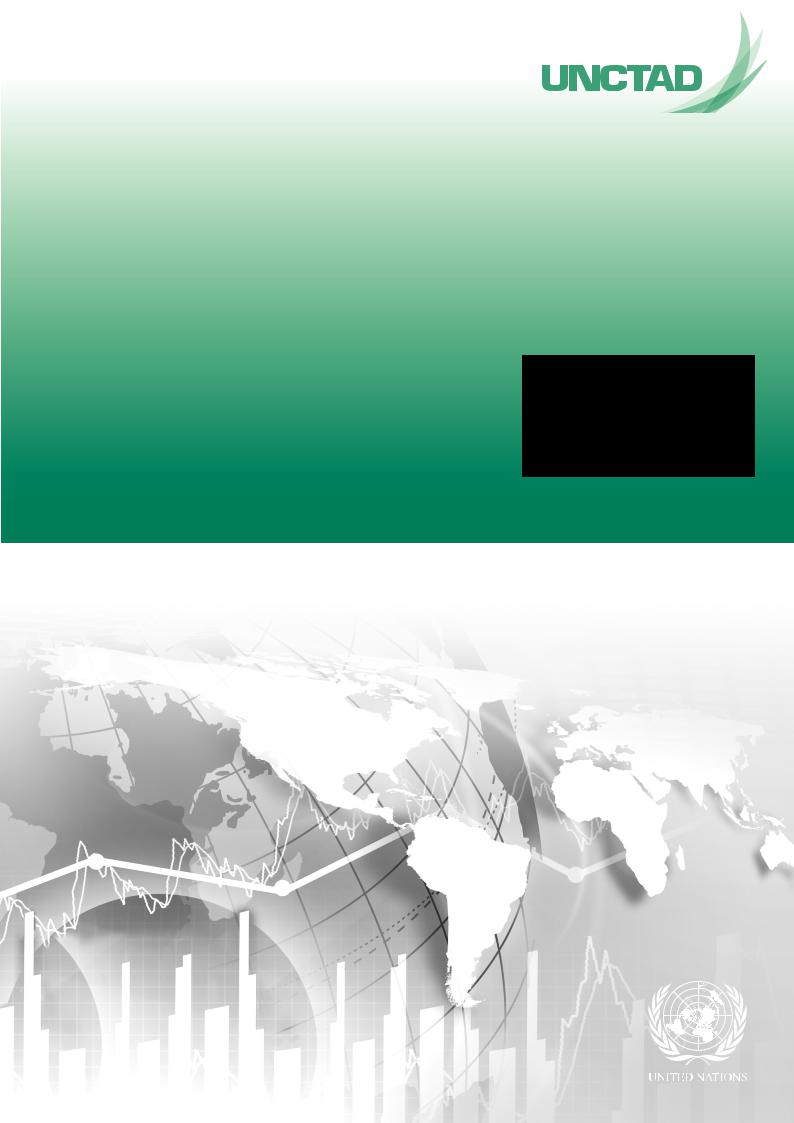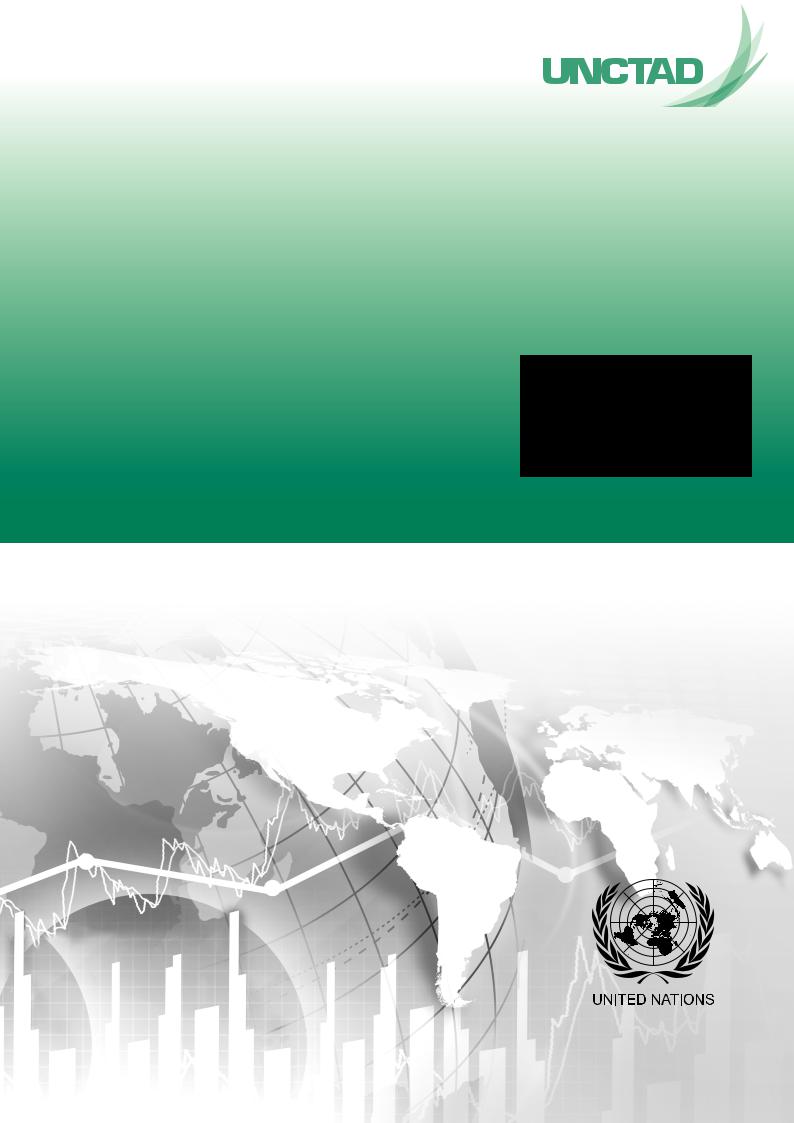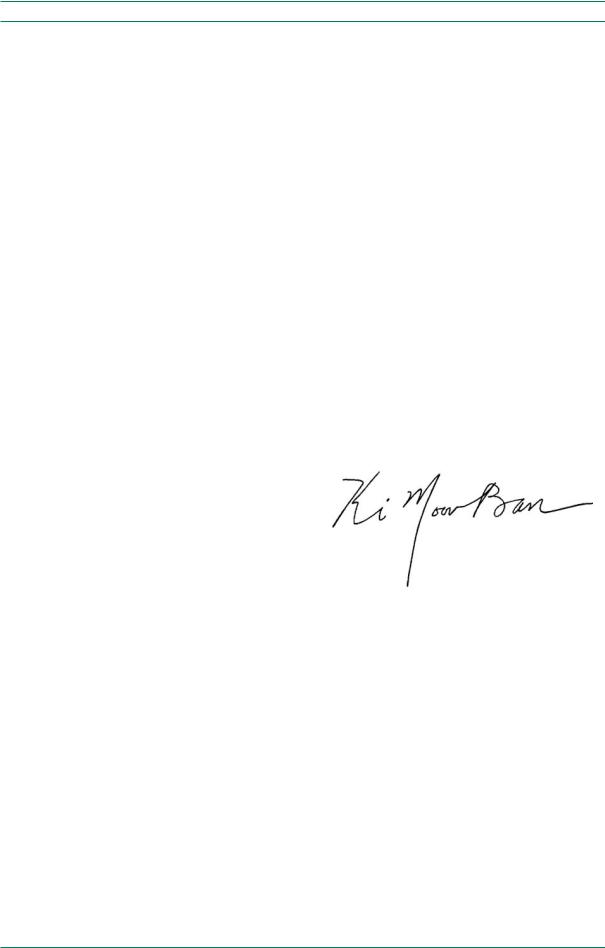
WORLD INVESTMENT REPORT 2012
.pdf
U n i t e d N at i o n s C o n f e r e n c e o n T r a d e A n d D e v e l
WORLD
INVESTMENT2012
REPORT
Towards a New Generation of Investment Policies

U N I T E D N AT I O N S C O N F E R E N C E O N T R A D E A N D D E V E L
WORLD
INVESTMENT2012
REPORT
TOWARDS A NEW GENERATION OF INVESTMENT POLICIES
New York and Geneva, 2012

ii |
World Investment Report 2012: Towards a New Generation of Investment Policies |
|
|
NOTE
The Division on Investment and Enterprise of UNCTAD is a global centre of excellence, dealing with issues related to investment and enterprise development in the United Nations System. It builds on three and a half decades of experience and international expertise in research and policy analysis, intergovernmental consensus-building, and provides technical assistance to developing countries.
The terms country/economy as used in this Report also refer, as appropriate, to territories or areas; the designations employed and the presentation of the material do not imply the expression of any opinion whatsoever on the part of the Secretariat of the United Nations concerning the legal status of any country, territory, city or area or of its authorities, or concerning the delimitation of its frontiers or boundaries. In addition, the designations of country groups are intended solely for statistical or analytical convenience and do not necessarily express a judgment about the stage of development reached by a particular country or area in the development process. The major country groupings used in this Report follow the classification of the United Nations Statistical Office. These are:
Developed countries: the member countries of the OECD (other than Chile, Mexico, the Republic of Korea and Turkey), plus the new European Union member countries which are not OECD members (Bulgaria, Cyprus, Latvia, Lithuania, Malta and Romania), plus Andorra, Bermuda, Liechtenstein, Monaco and San Marino.
Transition economies: South-East Europe and the Commonwealth of Independent States.
Developing economies: in general all economies not specified above. For statistical purposes, the data for China do not include those for Hong Kong Special Administrative Region (Hong Kong SAR), Macao Special Administrative Region (Macao SAR) and Taiwan Province of China.
Reference to companies and their activities should not be construed as an endorsement by UNCTAD of those companies or their activities.
The boundaries and names shown and designations used on the maps presented in this publication do not imply official endorsement or acceptance by the United Nations.
The following symbols have been used in the tables:
•Two dots (..) indicate that data are not available or are not separately reported. Rows in tables have been omitted in those cases where no data are available for any of the elements in the row;
•A dash (–) indicates that the item is equal to zero or its value is negligible;
•A blank in a table indicates that the item is not applicable, unless otherwise indicated;
•A slash (/) between dates representing years, e.g., 1994/95, indicates a financial year;
•Use of a dash (–) between dates representing years, e.g., 1994–1995, signifies the full period involved, including the beginning and end years;
•Reference to “dollars” ($) means United States dollars, unless otherwise indicated;
•Annual rates of growth or change, unless otherwise stated, refer to annual compound rates;
Details and percentages in tables do not necessarily add to totals because of rounding.
The material contained in this study may be freely quoted with appropriate acknowledgement.
UNITED NATIONS PUBLICATION
Sales No. E.12.II.D.3
ISBN 978-92-1-112843-7
Copyright © United Nations, 2012
All rights reserved
Printed in Switzerland

iii
PREFACE
Prospects for foreign direct investment (FDI) continue to be fraught with risks and uncertainties. At $1.5 trillion, flows of global FDI exceeded pre-financial crisis levels in 2011, but the recovery is expected to level off in 2012 at an estimated $1.6 trillion. Despite record cash holdings, transnational corporations have yet to convert available cash into new and sustained FDI, and are unlikely to do so while instability remains in international financial markets. Even so, half of the global total will flow to developing and transition economies, underlining the important development role that FDI can play, including in least developed countries.
A broader development policy agenda is emerging that has inclusive and sustainable development goals at its core. For investment policy, this new paradigm poses specific challenges. At the national level they include integrating investment policy into development strategy, incorporating sustainable development objectives, and ensuring relevance and effectiveness. At the international level it is necessary to strengthen the development dimension of international investment agreements, manage their complexity, and balance the rights and obligations of States and investors.
Against this background, this year’s World Investment Report unveils the UNCTAD Investment Policy Framework for Sustainable Development. Mobilizing investment for sustainable development is essential in this era of persistent crises and pressing social and environmental challenges. As we look ahead to the post-2015 development framework, I commend this important tool for the international investment community.
BAN Ki-moon
Secretary-General of the United Nations

iv |
World Investment Report 2012: Towards a New Generation of Investment Policies |
|
|
ACKNOWLEDGEMENTS
The World Investment Report 2012 (WIR12) was prepared by a team led by James Zhan. The team members included Richard Bolwijn, Quentin Dupriez, Kumi Endo, Masataka Fujita, Thomas van Giffen, Michael Hanni, Joachim Karl, Guoyong Liang, Anthony Miller, Hafiz Mirza, Nicole Moussa, Shin Ohinata, Sergey Ripinsky, Astrit Sulstarova, Elisabeth Tuerk and Jörg Weber. Wolfgang Alschner, Amare Bekele, Dolores Bentolila, Anna-Lisa Brahms, Joseph Clements, Hamed El Kady, Noelia Garcia Nebra, Ariel Ivanier, Elif Karakas, Abraham Negash, Faraz Rojid, Diana Rosert, Claudia Salgado, John Sasuya, Katharina Wortmann, Youngjun Yoo and intern Cree Jones also contributed to the Report.
WIR12 benefited from the advice of Lorraine Eden, Arvind Mayaram, Ted Moran, Rajneesh Narula, Karl Sauvant and Pierre Sauvé.
Bradley Boicourt and Lizanne Martinez provided research and statistical assistance. They were supported by Hector Dip and Ganu Subramanian. Production and dissemination of WIR12 was supported by Elisabeth Anodeau-Mareschal, Severine Excoffier, Rosalina Goyena, Natalia Meramo-Bachayani and Katia Vieu.
The manuscript was copy-edited by Lise Lingo and typeset by Laurence Duchemin and Teresita Ventura. Sophie Combette designed the cover.
At various stages of preparation, in particular during the seminars organized to discuss earlier drafts of WIR12, the team benefited from comments and inputs received from Masato Abe, Michael Addo, Ken-ichi Ando, Yuki Arai, Nathalie Bernasconi, Michael Bratt, Jeremy Clegg, Zachary Douglas, Roberto Echandi, Wenjie Fan, Alejandro Faya, Stephen Gelb, Robert Howse, Christine Kaufmann, Anna Joubin-Bret, Jan Kleinheisterkamp, John Kline, Galina Kostyunina, Markus Krajewski, Padma Mallampally, Kate Miles, Peter Muchlinski, Marit Nilses, Federico Ortino, Joost Pauwelyn, Andrea Saldarriaga, Stephan Schill, Jorge Vinuales, Stephen Young and Zbigniew Zimny. Comments were also received from numerous UNCTAD colleagues, including Kiyoshi Adachi, Stephania Bonilla, Chantal Dupasquier, Fulvia Farinelli, Torbjörn Fredriksson, Kálmán Kalotay, Fiorina Mugione, Christoph Spennemann, Paul Wessendorp, Richard KozulWright and colleagues from the Division on Globalization and Development Strategies and the Division on International Trade and Commodities.
Numerous officials of central banks, government agencies, international organizations and non-governmental organizations also contributed to WIR12. The financial support of the Governments of Finland, Norway, Sweden and Switzerland is gratefully acknowledged.

|
|
v |
|
TABLE OF CONTENTS |
|
PREFACE ............................................................................................................. |
iii |
|
ACKNOWLEDGEMENTS ........................................................................................ |
iv |
|
ABBREVIATIONS .................................................................................................. |
ix |
|
KEY MESSAGES .................................................................................................. |
xi |
|
OVERVIEW ......................................................................................................... |
xiii |
|
CHAPTER I. GLOBAL INVESTMENT TRENDS ............................................................ |
1 |
|
A. GLOBAL FDI FLOWS .......................................................................................... |
2 |
|
1. |
Overall trends ............................................................................................................................... |
2 |
|
a. FDI by geography ..................................................................................................................................... |
3 |
|
b. FDI by mode of entry ................................................................................................................................ |
6 |
|
c. FDI by sector and industry ....................................................................................................................... |
8 |
|
d. Investments by special funds ................................................................................................................. |
10 |
2. |
Prospects ................................................................................................................................... |
16 |
|
a. By mode of entry..................................................................................................................................... |
18 |
|
b. By industry.............................................................................................................................................. |
19 |
|
c. By home region....................................................................................................................................... |
20 |
|
d. By host region......................................................................................................................................... |
21 |
B. INTERNATIONAL PRODUCTION AND THE LARGEST TNCS ................................... |
23 |
|
1. |
International production ............................................................................................................ |
23 |
2. |
Disconnect between cash holdings and investment levels of the largest TNCs ......................... |
26 |
C. FDI ATTRACTION, POTENTIAL AND CONTRIBUTION INDICES .............................. |
29 |
|
1. |
Inward FDI Attraction and Potential Indices ............................................................................. |
29 |
2. |
Inward FDI Contribution Index .................................................................................................. |
32 |
CHAPTER II. REGIONAL TRENDS IN FDI ................................................................ |
37 |
|
INTRODUCTION.................................................................................................... |
38 |
|
A. REGIONAL TRENDS ......................................................................................... |
39 |
|
1. |
Africa .......................................................................................................................................... |
39 |
2. |
East and South-East Asia .......................................................................................................... |
42 |
3. |
South Asia .................................................................................................................................. |
45 |
4. |
West Asia ................................................................................................................................... |
48 |
5. |
Latin America and the Caribbean ............................................................................................. |
52 |
6. |
Transition economies ................................................................................................................. |
56 |
7. |
Developed countries .................................................................................................................. |
60 |
B. TRENDS IN STRUCTURALLY WEAK, VULNERABLE AND SMALL ECONOMIES ....... |
64 |
|
1. |
Least developed countries ........................................................................................................ |
64 |
2. |
Landlocked developing countries ............................................................................................. |
67 |
3. |
Small island developing States ................................................................................................. |
70 |
CHAPTER III. RECENT POLICY DEVELOPMENTS ..................................................... |
75 |
|
A. NATIONAL POLICY DEVELOPMENTS ................................................................. |
76 |
|
1. |
Investment liberalization and promotion remained high on the policy agenda ......................... |
77 |

vi |
World Investment Report 2012: Towards a New Generation of Investment Policies |
|
2. |
State regulation with regard to inward FDI continued ............................................................. |
79 |
|
a. Adjusting entry policies with regard to inward FDI ................................................................................. |
79 |
|
b. More State influence in extractive industries ......................................................................................... |
79 |
3. |
More critical approach towards outward FDI ........................................................................... |
81 |
4. |
Policy measures affecting the general business climate remain important ........................... |
81 |
5. |
Conclusion: Common challenges in designing FDI policies .................................................... |
81 |
B. INTERNATIONAL INVESTMENT POLICIES .......................................................... |
84 |
|
1. |
Regional treaty making is gradually moving to centre stage ................................................... |
84 |
2. |
Growing discontent with ISDS .................................................................................................. |
86 |
3. |
ISDS: unfinished reform agenda ............................................................................................... |
88 |
4. |
Enhancing the sustainable development dimension of international |
|
|
investment policies .................................................................................................................... |
89 |
|
a. IIA-related developments ....................................................................................................................... |
89 |
|
b. Other developments ............................................................................................................................... |
91 |
C. CORPORATE SOCIAL RESPONSIBILITY IN GLOBAL SUPPLY CHAINS .................... |
93 |
|
1. |
Supplier codes of conduct and implementation challenges ................................................... |
93 |
|
a. Proliferation of CSR codes ..................................................................................................................... |
93 |
|
b. Challenges for suppliers (particularly SMEs) in developing countries ................................................... |
93 |
2. |
Policy options for effective promotion of CSR standards in global supply chains .................... |
94 |
CHAPTER IV. INVESTMENT POLICY FRAMEWORK FOR |
|
|
SUSTAINABLE DEVELOPMENT ............................................................................. |
97 |
|
A. INTRODUCTION .............................................................................................. |
98 |
|
B. A “NEW GENERATION” OF INVESTMENT POLICIES ............................................ |
99 |
|
1. |
The changing investment policy environment .......................................................................... |
99 |
2. |
Key investment policy challenges ........................................................................................... |
102 |
3. |
Addressing the challenges: UNCTAD’s Investment Policy Framework |
|
|
for Sustainable Development .................................................................................................. |
104 |
C. CORE PRINCIPLES FOR INVESTMENT POLICYMAKING ..................................... |
106 |
|
1. |
Scope and objectives of the Core Principles ......................................................................... |
106 |
2. |
Core Principles for investment policymaking for sustainable development ............................ |
107 |
3. |
Annotations to the Core Principles ......................................................................................... |
108 |
D. NATIONAL INVESTMENT POLICY GUIDELINES ................................................. |
111 |
|
1. |
Grounding investment policy in development strategy ......................................................... |
111 |
2. |
Designing policies for responsible investment and sustainable development ........................ |
116 |
3. |
Implementation and institutional mechanisms for policy effectiveness .................................. |
118 |
4. |
The IPFSD’s national policy guidelines ................................................................................... |
120 |
E. ELEMENTS OF INTERNATIONAL INVESTMENT AGREEMENTS: POLICY OPTIONS .. |
132 |
|
1. |
Defining the role of IIAs in countries’ development strategy and |
|
|
investment policy ..................................................................................................................... |
133 |
2. |
Negotiating sustainable-development-friendly IIAs ............................................................... |
135 |
3. |
IIA elements: policy options .................................................................................................... |
140 |
4. |
Implementation and institutional mechanisms for policy effectiveness ............................... |
160 |
F. THE WAY FORWARD ..................................................................................... |
161 |
|
REFERENCES................................................................................................... |
165 |
|
ANNEX TABLES ............................................................................................... |
167 |
|
SELECTED UNCTAD PUBLICATIONS ON TNCS AND FDI ....................................... |
203 |
|

|
|
vii |
|
Boxes |
|
I.1. |
The increasing importance of indirect FDI flows........................................................................ |
7 |
I.2. |
World Investment Prospects Survey 2012–2014: methodology and results........................... |
19 |
I.3. |
UNCTAD’s FDI Attraction, Potential and Contribution Indices................................................ |
30 |
II.1. |
Attracting investment for development: old challenges and new opportunities |
|
|
for South Asia ............................................................................................................................ |
47 |
II.2. |
Economic diversification and FDI in the GCC countries ........................................................... |
50 |
II.3. |
The Russian Federation’s accession to the WTO: implications for inward FDI flows ............... |
58 |
III.1. |
Investment Policy Monitor database: revised methodology .................................................. |
77 |
III.2. |
Examples of investment liberalization measures in 2011–2012 ............................................. |
78 |
III.3. |
Examples of investment promotion and facilitation measures in 2011–2012 .......................... |
78 |
III.4. |
Examples of FDI restrictions and regulations in 2011–2012 ................................................... |
80 |
III.5. |
Selected policy measures affecting the general business climate in 2011–2012 ..................... |
81 |
III.6. |
FDI and “green” protectionism ................................................................................................. |
83 |
IV.1. |
Defining investment protectionism ........................................................................................ |
101 |
IV.2. |
Scope of the IPFSD ................................................................................................................ |
105 |
IV.3. |
The origins of the Core Principles in international law .......................................................... |
106 |
IV.4. |
Integrating investment policy in development strategy: UNCTAD’s |
|
|
Investment Policy Reviews ..................................................................................................... |
112 |
IV.5. |
UNCTAD’s Entrepreneurship Policy Framework .................................................................... |
115 |
IV.6. |
Designing sound investment rules and procedures: UNCTAD’s |
|
|
Investment Facilitation Compact ........................................................................................... |
117 |
IV.7. |
Investment policy advice to “adapt and adopt”: UNCTAD’s Series on |
|
|
Best Practices in Investment for Development ..................................................................... |
122 |
IV.8. |
Pre-establishment commitments in IIAs ................................................................................ |
137 |
IV.9. |
Special and differential treatment (SDT) and IIAs .................................................................. |
138 |
|
Box Tables |
|
I.1.1. FDI stock in financial holding companies, 2009......................................................................... |
7 |
|
I.1.2. Inward FDI stock in the United States, by immediate and ultimate |
|
|
|
source economy, 2000 and 2010................................................................................................. |
8 |
I.3.1. Measuring FDI Potential: FDI determinants and proxy indicators........................................... |
30 |
|
IV.4.1.Beneficiaries of the UNCTAD IPR program, 1999–2011 ........................................................ |
112 |
|
IV.6.1.Beneficiaries of selected programs of UNCTAD’s Investment |
|
|
|
Facilitation Compact ............................................................................................................... |
117 |
|
Box Figures |
|
II.2.1. Accumulated inward FDI stock in Oman, Qatar and Saudi Arabia, |
|
|
|
by sector, 2010 .......................................................................................................................... |
50 |
IV.5.1. Key components of UNCTAD’s Entrepreneurship Policy Framework .................................. |
115 |
|
|
Figures |
|
I.1. |
UNCTAD’s Global FDI Quarterly Index, 2007 Q1–2012 Q1......................................................... |
2 |
I.2. |
FDI inflows, global and by group of economies, 1995–2011..................................................... |
3 |

viii |
World Investment Report 2012: Towards a New Generation of Investment Policies |
|
I.3. |
FDI inflows in developed countries by component, 2005–2011................................................ |
4 |
I.4. |
FDI outflow shares by major economic groups, 2000–2011...................................................... |
4 |
I.5. |
Value of cross-border M&As and greenfield FDI projects worldwide, 2007–2011.................... |
6 |
I.6. |
Cross-border M&As by private equity firms, by sector and main industry, 2005 |
|
|
and 2011..................................................................................................................................... |
13 |
I.7. |
Annual and cumulative value of FDI by SWFs, 2000–2011...................................................... |
14 |
I.8. |
Profitability and profit levels of TNCs, 1999–2011.................................................................... |
17 |
I.9. |
Global FDI flows, 2002–2011, and projection for 2012–2014................................................... |
17 |
I.10. |
FDI flows by group of economies, 2002–2011, and projection for 2012–2014....................... |
17 |
I.11. |
TNCs’ perception of the global investment climate, 2012–2014............................................. |
18 |
I.12. |
Importance of equity and non-equity modes of entry, 2012 and 2014.................................... |
20 |
I.13. |
IPAs’ selection of most promising investor home economies for FDI in 2012–2014.............. |
21 |
I.14. |
TNCs’ top prospective host economies for 2012–2014........................................................... |
22 |
I.15. |
Top investors among the largest TNCs, 2011........................................................................... |
25 |
I.16. |
Top 100 TNCs: cash holdings, 2005–2011................................................................................ |
26 |
I.17. |
Top 100 TNCs: major cash sources and uses, 2005–2011...................................................... |
27 |
I.18. |
Top 100 TNCs: capital expenditures and acquisitions, 2005–2011......................................... |
27 |
I.19. |
FDI Attraction Index: top 10 ranked economies, 2011............................................................. |
29 |
I.20. |
FDI Attraction Index vs FDI Potential Index Matrix, 2011........................................................ |
32 |
I.21. |
FDI Contribution Index vs FDI presence, 2011......................................................................... |
35 |
II.1. |
Value of greenfield investments in Africa, by sector, 2003–2011 ............................................ |
41 |
III.1. |
National regulatory changes, 2000–2011 ................................................................................. |
76 |
III.2. |
BITs and “other IIAs”, 2006–2011 .............................................................................................. |
84 |
III.3. |
Numbers and country coverage of BITs and “other IIAs”, 2006–2011 ................................... |
85 |
III.4. |
Known investor-State treaty-based disputes, 1987–2011 ...................................................... |
87 |
IV.1. |
Structure and components of the IPFSD ............................................................................... |
104 |
|
Tables |
|
I.1. |
Share of FDI projects by BRIC countries, by host region, average 2005–2007 |
|
|
(pre-crisis period) and 2011......................................................................................................... |
6 |
I.2. |
Sectoral distribution of FDI projects, 2005–2011....................................................................... |
9 |
I.3. |
Distribution shares and growth rates of FDI project values, by sector/industry, 2011........... |
10 |
I.4. |
Cross-border M&As by private equity firms, 1996–2011.......................................................... |
12 |
I.5. |
FDI by SWFs by host region/country, cumulative flows, 2005–2011....................................... |
15 |
I.6. |
FDI by SWFs by sector/industry, cumulative flows, 2005–2011.............................................. |
15 |
I.7. |
Summary of econometric results of medium-term baseline scenarios of FDI flows, |
|
|
by region..................................................................................................................................... |
19 |
I.8. |
Selected indicators of FDI and international production, 1990–2011..................................... |
24 |
I.9. |
Internationalization statistics of the 100 largest non-financial TNCs worldwide |
|
|
and from developing and transition economies....................................................................... |
25 |
I.10. |
UNCTAD’s FDI Contribution Index, by host region, 2009......................................................... |
33 |
I.11. |
FDI Contribution Index median values, by indicator................................................................ |
34 |
II.1. |
FDI flows, by region, 2009–2011 .............................................................................................. |
38 |
II.2. |
FDI inflows to Greece, Italy, Portugal and Spain, by component, 2007–2011........................ |
63 |
II.3. |
FDI outflows from Greece, Italy, Portugal and Spain, by component, 2007–2011................. |
63 |
II.4. |
The 10 largest greenfield projects in LDCs, 2011 .................................................................... |
65 |
II.5. |
The 10 largest greenfield projects in LLDCs, 2011 ................................................................. |
69 |
II.6. |
Selected largest M&A sales in SIDS, 2011 .............................................................................. |
71 |
II.7. |
The 10 largest greenfield projects in SIDS, 2011 .................................................................... |
72 |
III.1. |
National regulatory changes, 2000–2011 ................................................................................. |
76 |
III.2. |
National regulatory changes in 2011, by industry ................................................................... |
77 |
III.3. |
Examples of sustainable-development-friendly aspects of selected IIAs signed in 2011 ........ |
90 |
